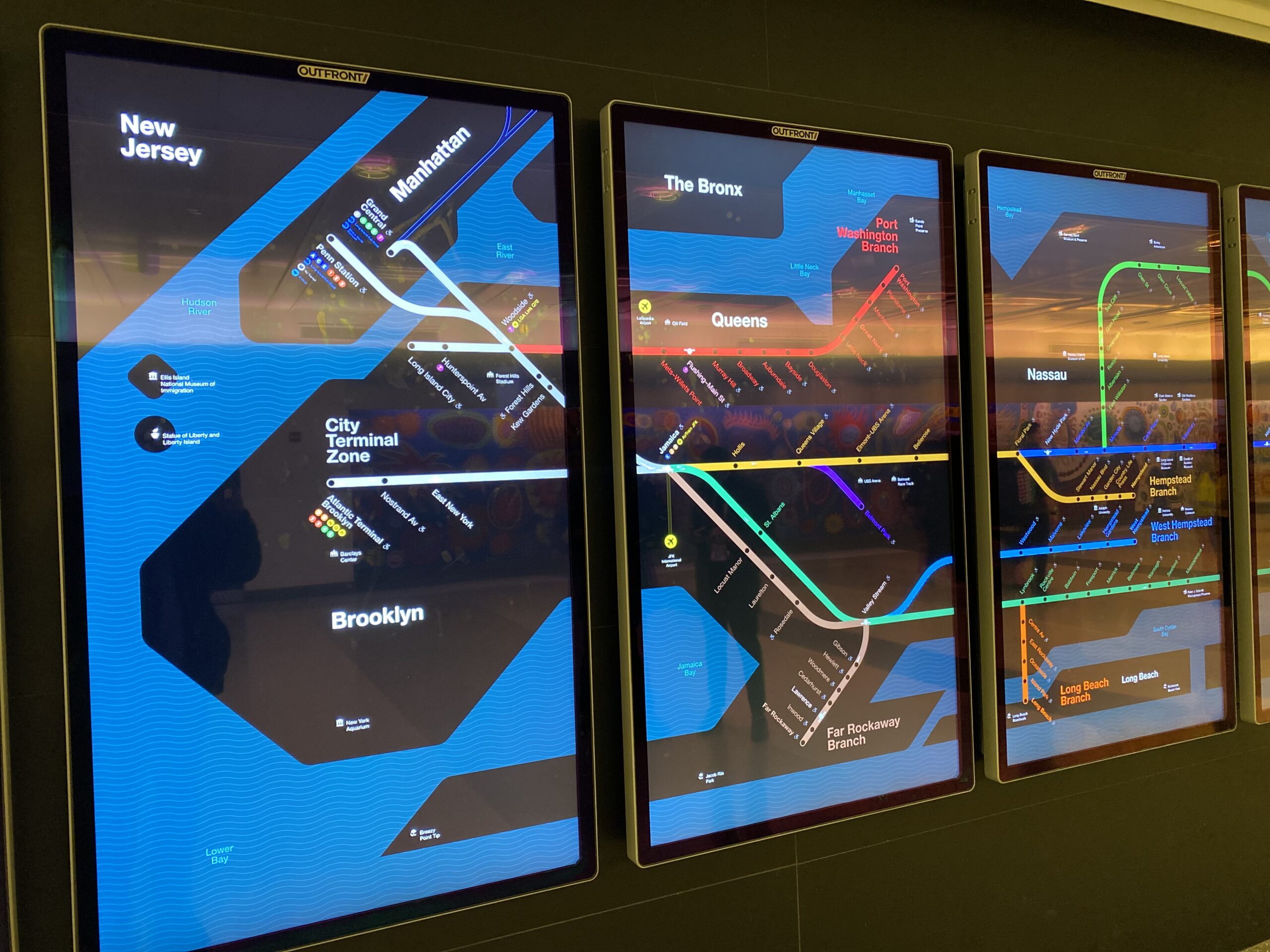
The impressive culmination of decades of planning and years of tunneling and construction from Long Island City, Queens to Manhattan’s East Side, MTA Long Island Rail Road’s new East Side Terminal has opened to revenue service. Situated deep beneath the Dining Concourse and Tracks 11 – 42 of the majestic Grand Central Terminal, the LIRR’s Grand Central Madison resembles nothing less than a 21st century version of its grander older sibling, decorated with gorgeous marble, tiled concourses, and arched entry ways. But what sets this new terminal apart is the digital customer experience embedded in its design.
“The opening of LIRR’s spectacular new terminal at Grand Central Madison has transformed regional rail transportation, creating new connectivity between LIRR and Metro-North and significantly upgrading the customer experience for LIRR customers traveling to the East Side of Manhattan,” said Catherine Rinaldi, Interim President of the Long Island Rail Road and President of Metro-North Railroad. “Clear, bright, and well-placed digital signage throughout the terminal is a key element of that improved customer experience and has proven enormously helpful in assisting customers with wayfinding and trip planning as they acquaint themselves with the new service.”
The Cultural Corridor
The Grand Central Madison digital journey begins almost as soon as customers pass through the entrance at the south end of the terminal at 43rd St and walk through what the MTA is calling the “Cultural Corridor.”
Eight column mounted Full HD OutFront Media advertising displays by Videri greet passengers as they enter. These 65” ON.6XT model Live Boards display a combination of advertising, LIRR content and customer generated content – so called MTAScapes, photos taken of or around the railroad. The content is pushed to these UHD displays by the OutFront CMS which is integrated with the MTA’s Mercury CMS. The software ensures content playback is synchronized to each of the individually addressed displays.
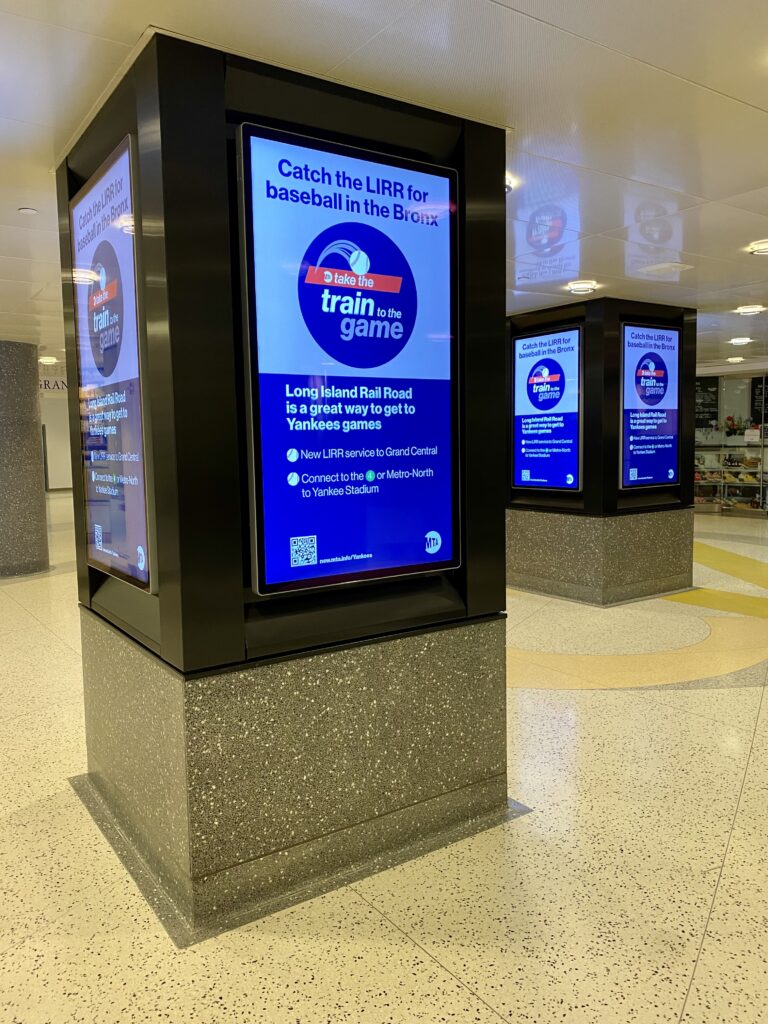
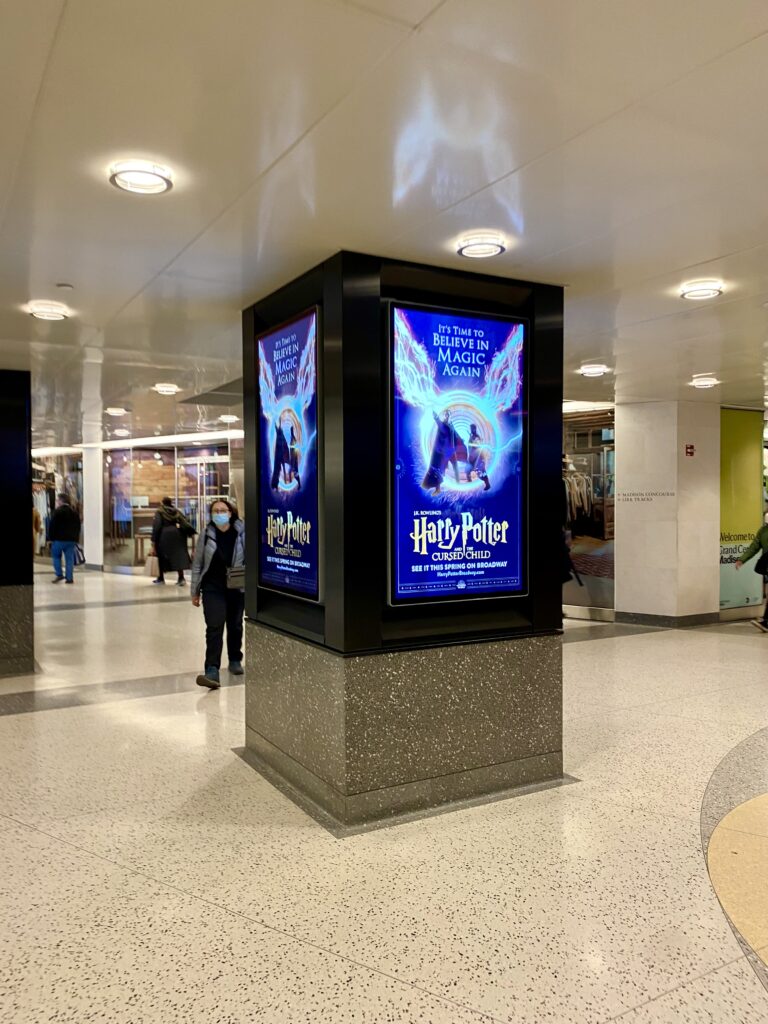
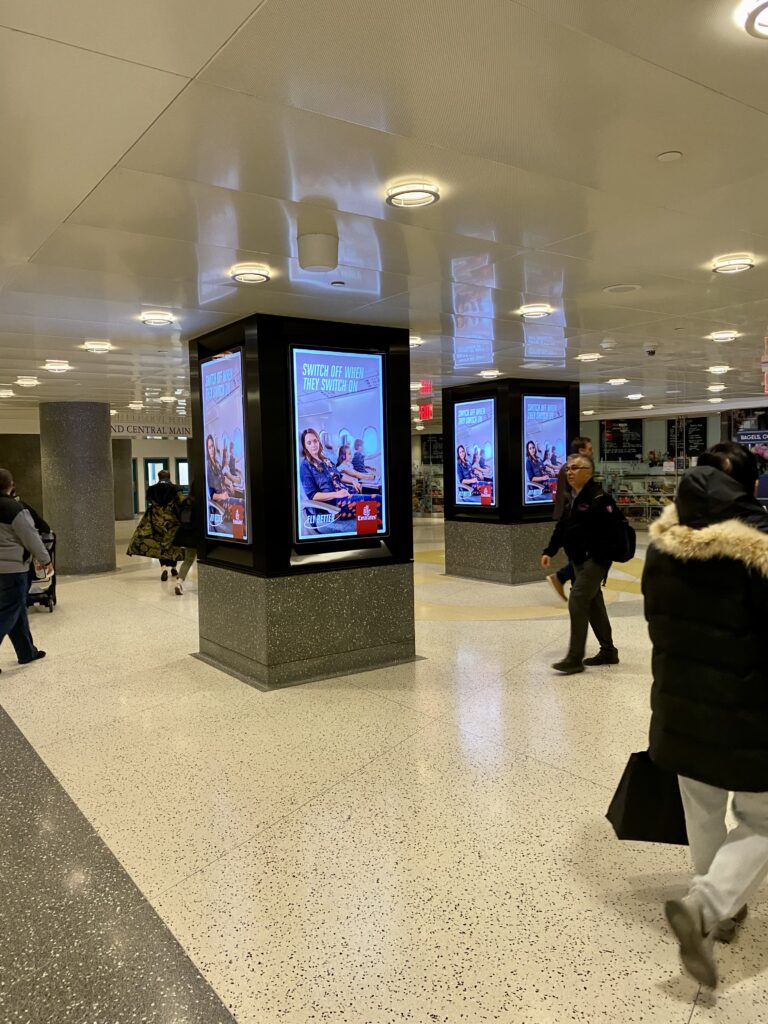
“OUTFRONT’s Live Boards in Grand Central Madison, and throughout the MTA, provide vital information for riders’ journeys, as well as entertaining and informing them with advertising and timely curated content,” said Jason Kuperman, Chief Product Experience Officer at OUTFRONT.
In addition to these eight displays, there are five (5) MTA Customer Information Center’s (CIC) located throughout the terminal. The CIC screens are a combination of ON.5XT 49” and more 65” Videri screens, deployed in pairs of two portrait mounted units.
“Our clients often ask us about the deployment at Grand Central Madison because it’s so visible,” said Rolf Carlson, SVP and Head of Sales at Videri. “We are proud of this deployment and see it as a living testament to our commitment to innovation and a representation of our engineering capabilities.”
As passengers continue toward the Madison Concourse, they encounter a series of five (5) double-sided, custom built large format backlit LED Lightboxes. While not digital, these impressive 75” x 100” pedestal mounted units will feature rotating exhibitions curated by MTA Arts & Design showcasing the work of contemporary artists and photographers. For the terminal’s opening, the screens are displaying “Still Life,” a series of photographs by Paul Pfeiffer profiling iconic Times Square street performer Da Gold Man, curated by International Center of Photography (ICP) Executive Director David E. Little.
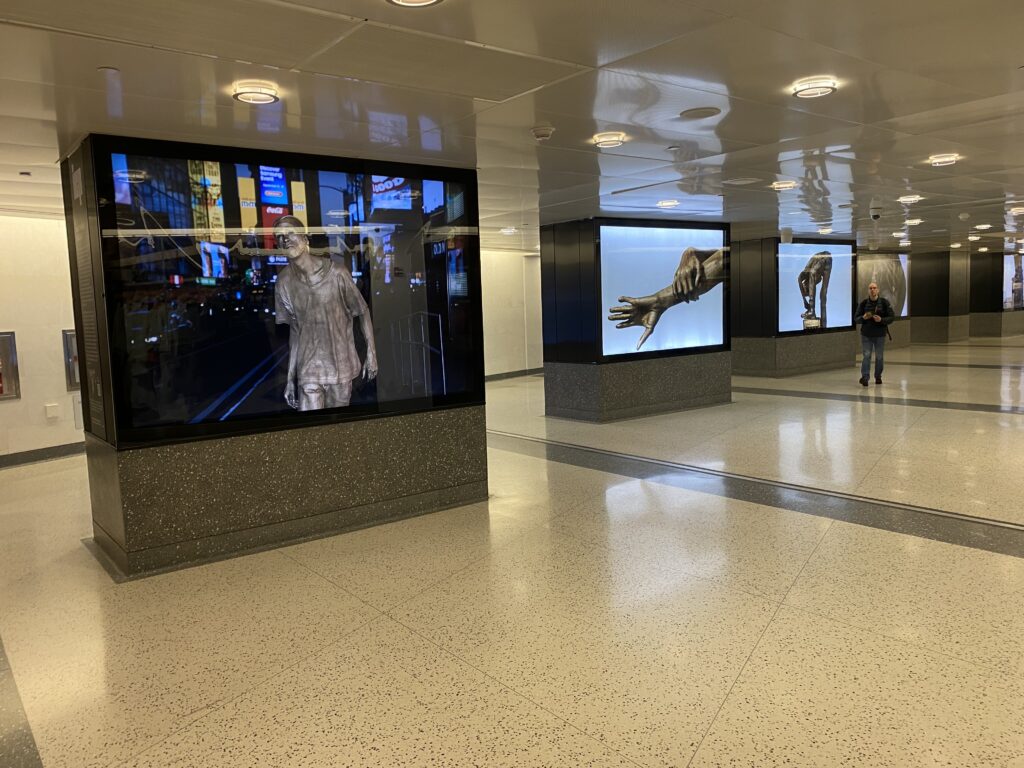
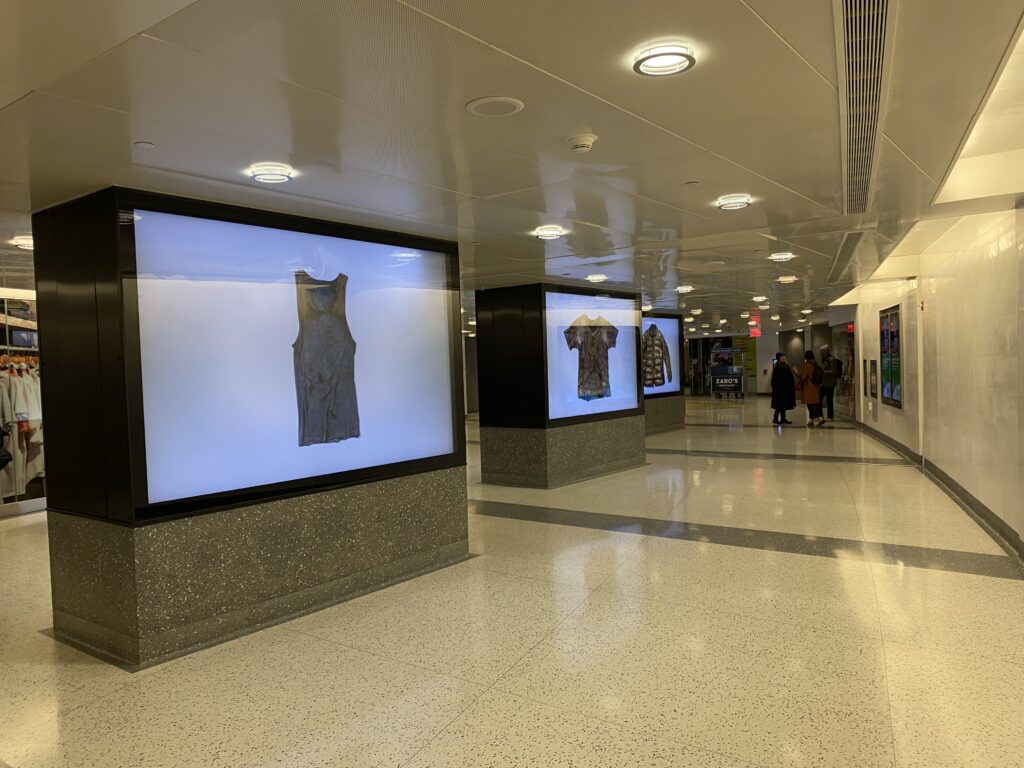
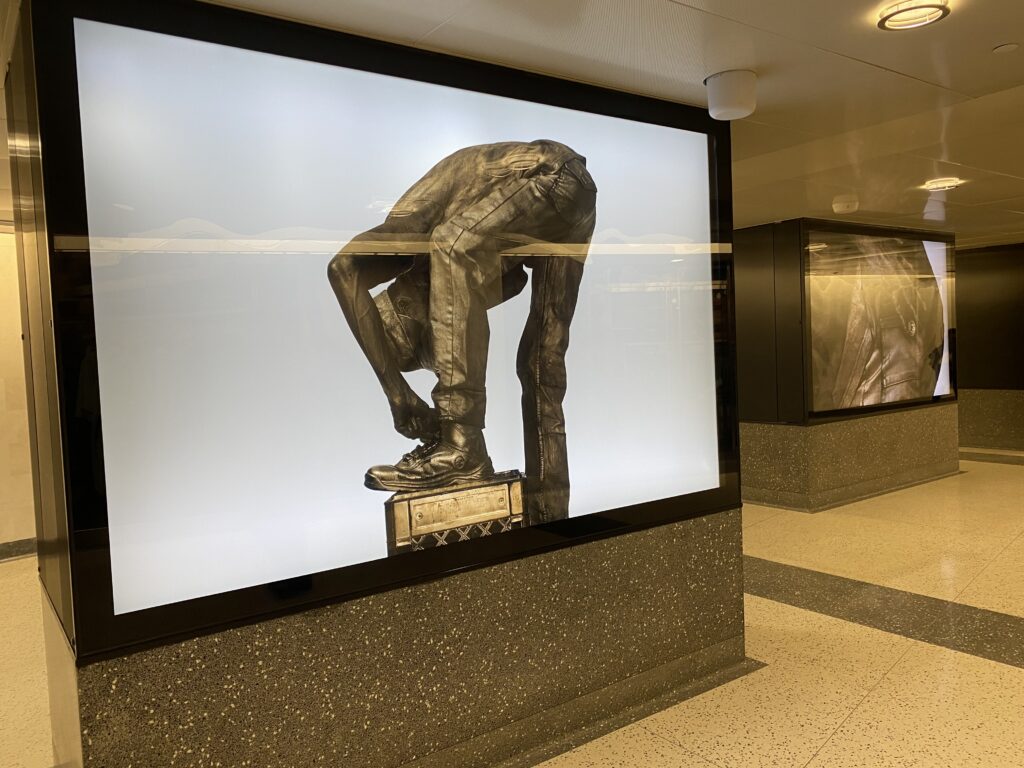
“Arts & Design is pleased to be collaborating with ICP as we expand our photography program in the new Grand Central Madison,” said Sandra Bloodworth, Director, MTA Arts & Design. “In this inaugural exhibition, the performance of the iconic Da Gold Man is brought to life through Pfeiffer’s perceptive lens. We are very excited to share this body of work in the new large-scale lightboxes, steps from permanent works by Kiki Smith and Yayoi Kusama, which together form a rich cultural corridor in the new Grand Central Madison.”
Digital Customer Information
The digital customer information experience continues as riders make their way further into the terminal via the Madison Concourse. At crucial points along the passenger journey Train Information Displays are deployed to help customers determine their travel options. The boards, which resemble airport FIDS, feature 49” portrait mounted 1080 x 1920 LG Thin-Film-Transistor LCD screens in three-panel arrays. Using LIRR Train Time data the displays list, in alphabetical order, all train destinations available from GCM. Each line entry is paired with the appropriate color-coded branch line and includes departure time, fare, transfer and track information.
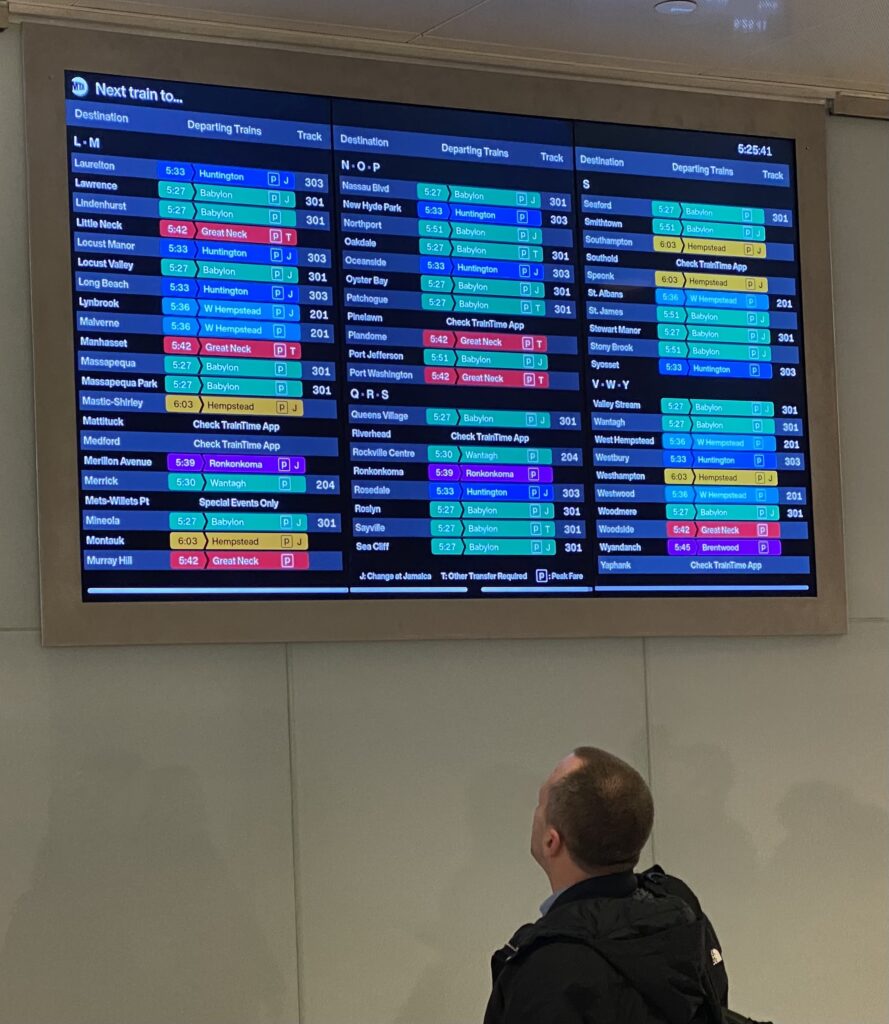
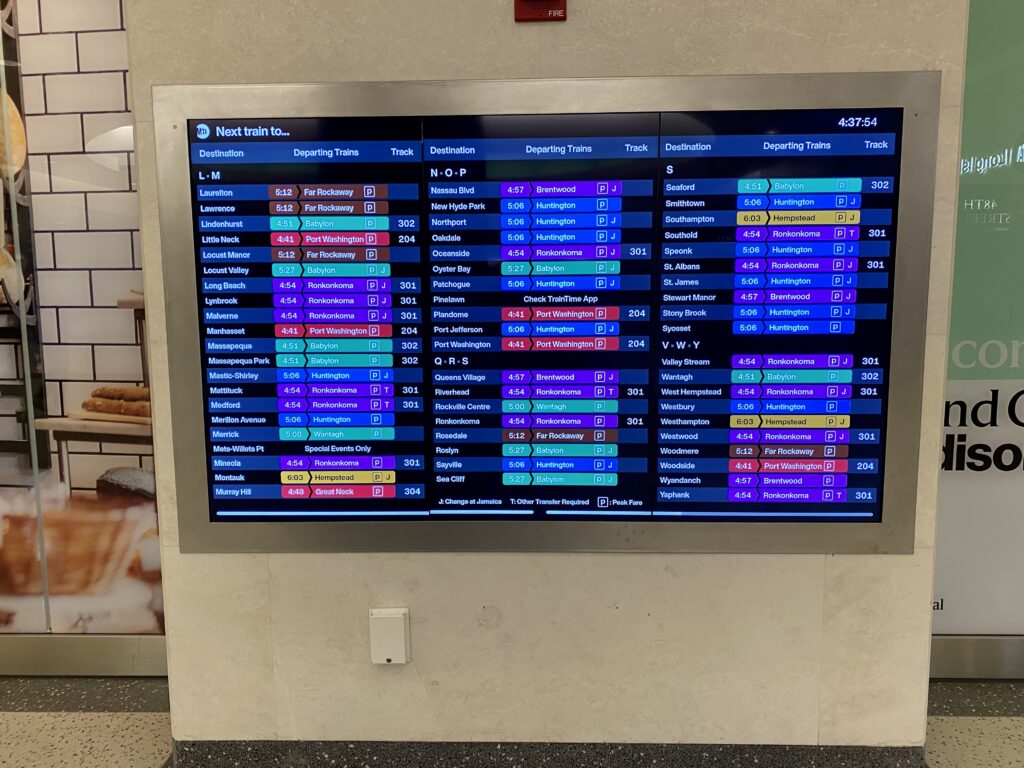
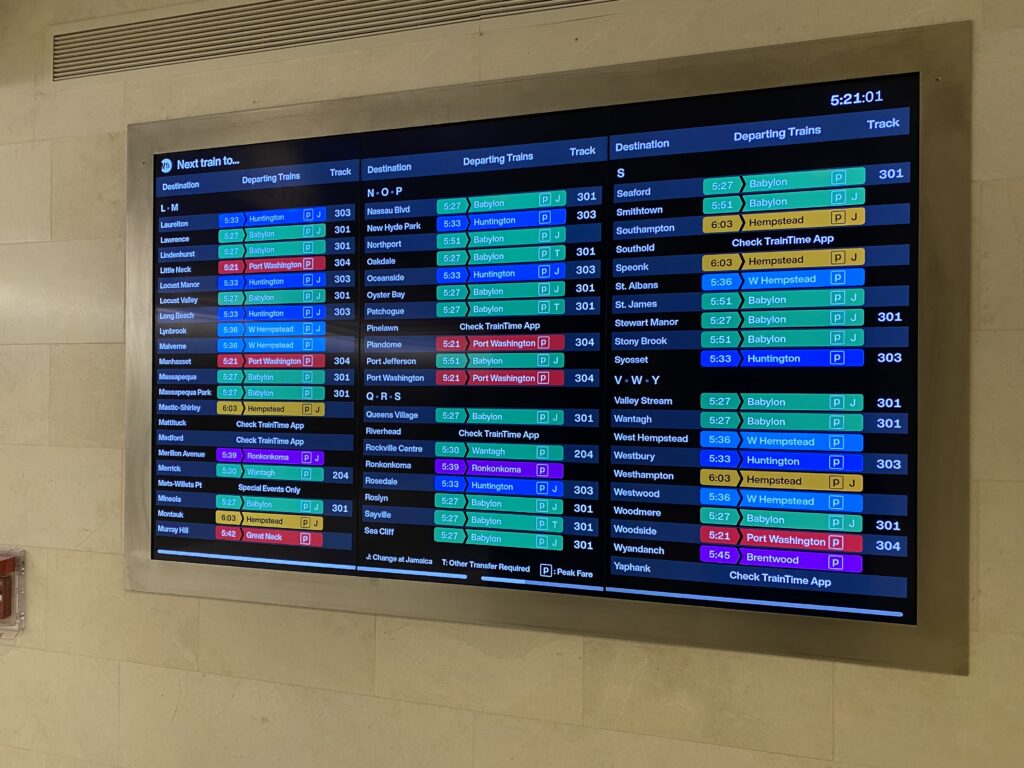
Seven stand-alone Connection Boards, made up of two (2) landscape mounted 49” 1920 x 1080 TFT LCD screens, provide track information for the next eight (8) east-bound trains at other points along the concourse. Using LIRR Train Time data the simple displays show destination, departure time and track assignment.
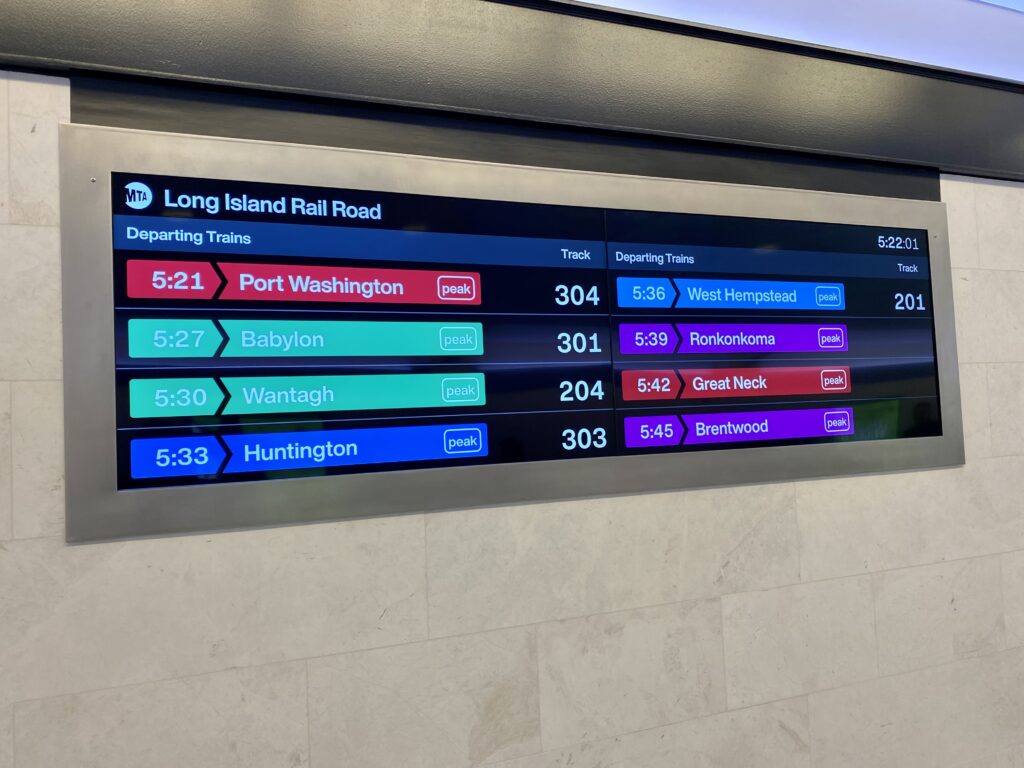
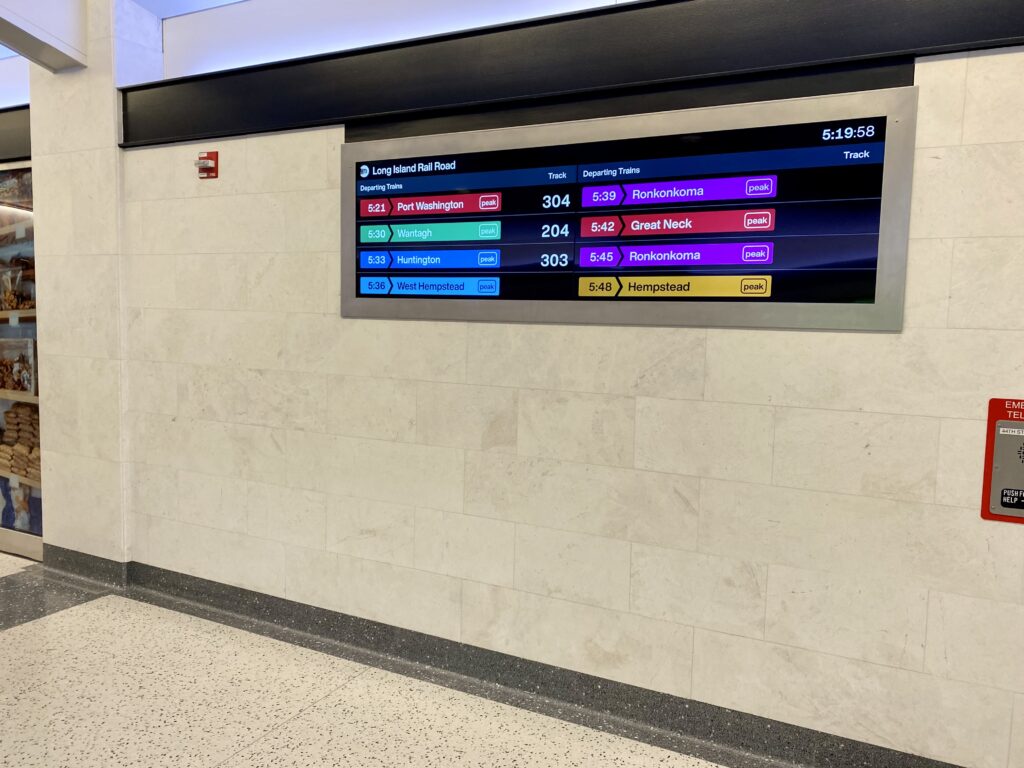
Throughout the Madison Concourse customers can also check train information on so-called Alpha Boards made up of five (5) portrait mounted 49” TFT LCD screens. In addition to train information, they can also display Service Alerts, general wayfinding and other MTA content.
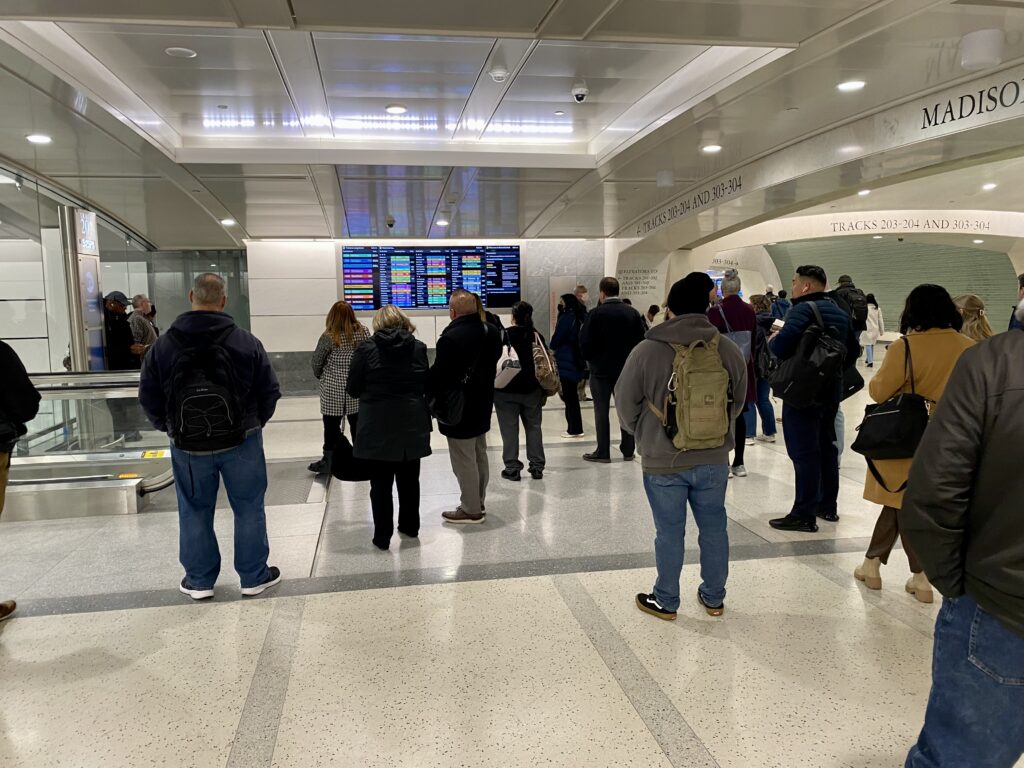
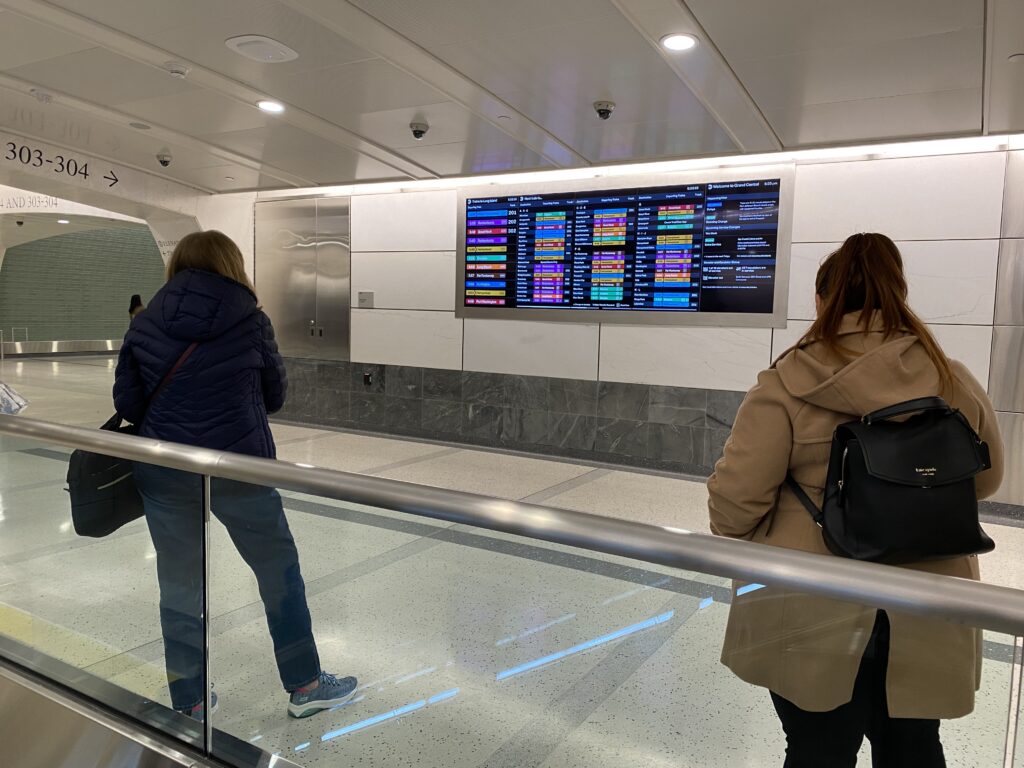
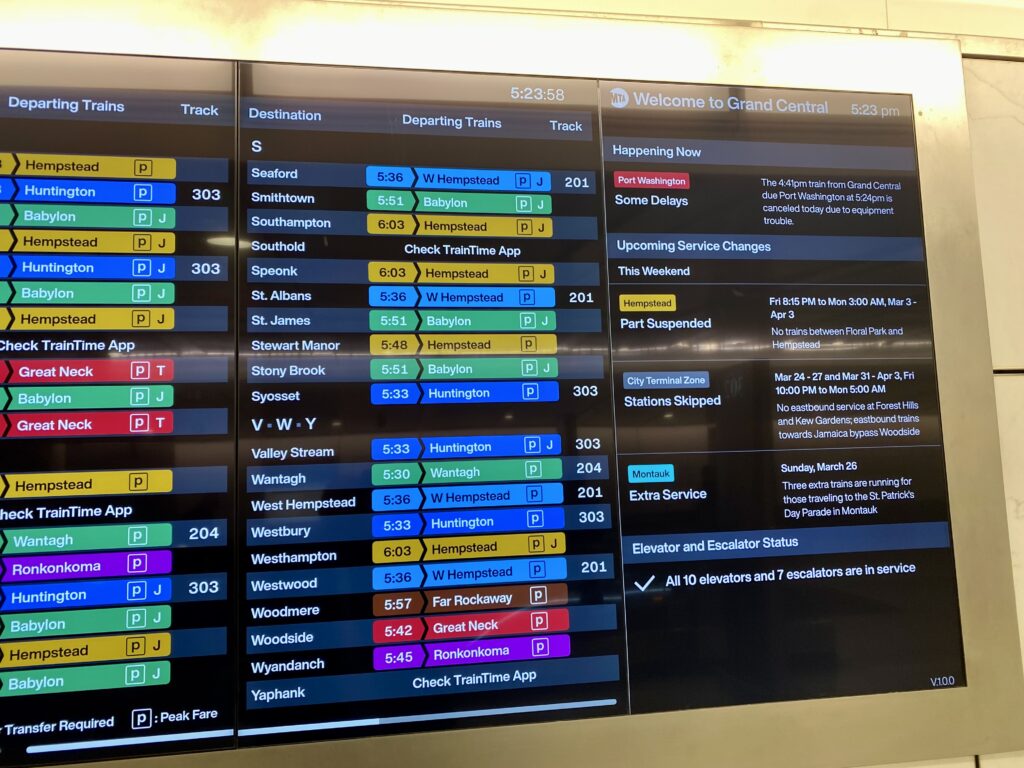
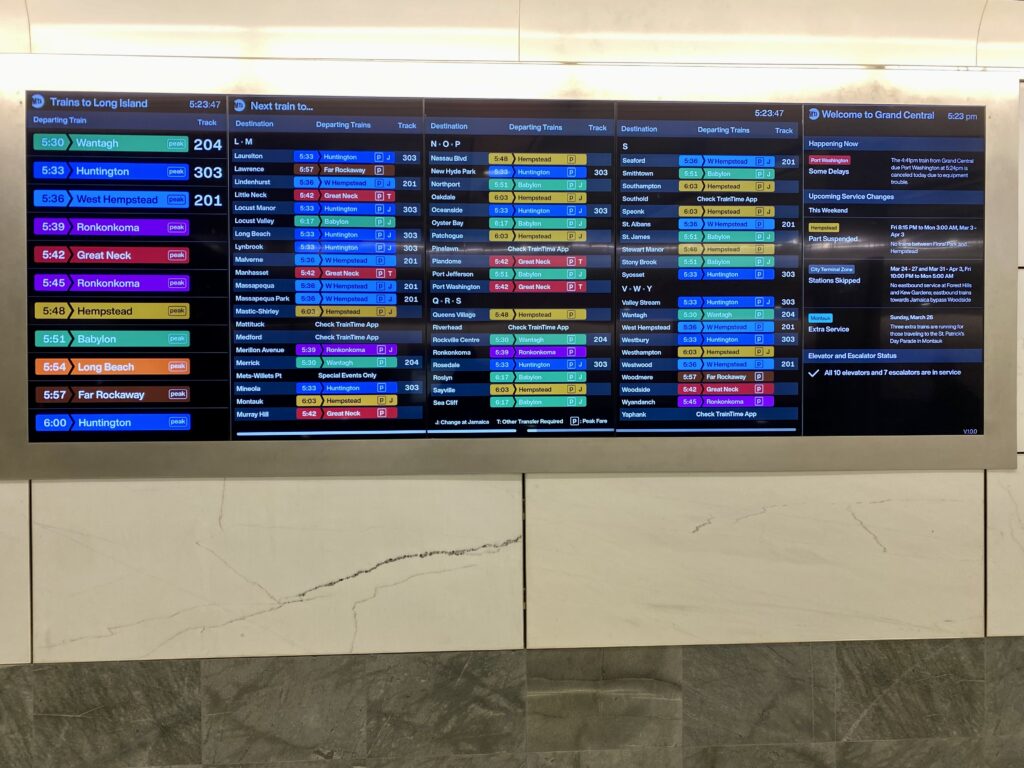
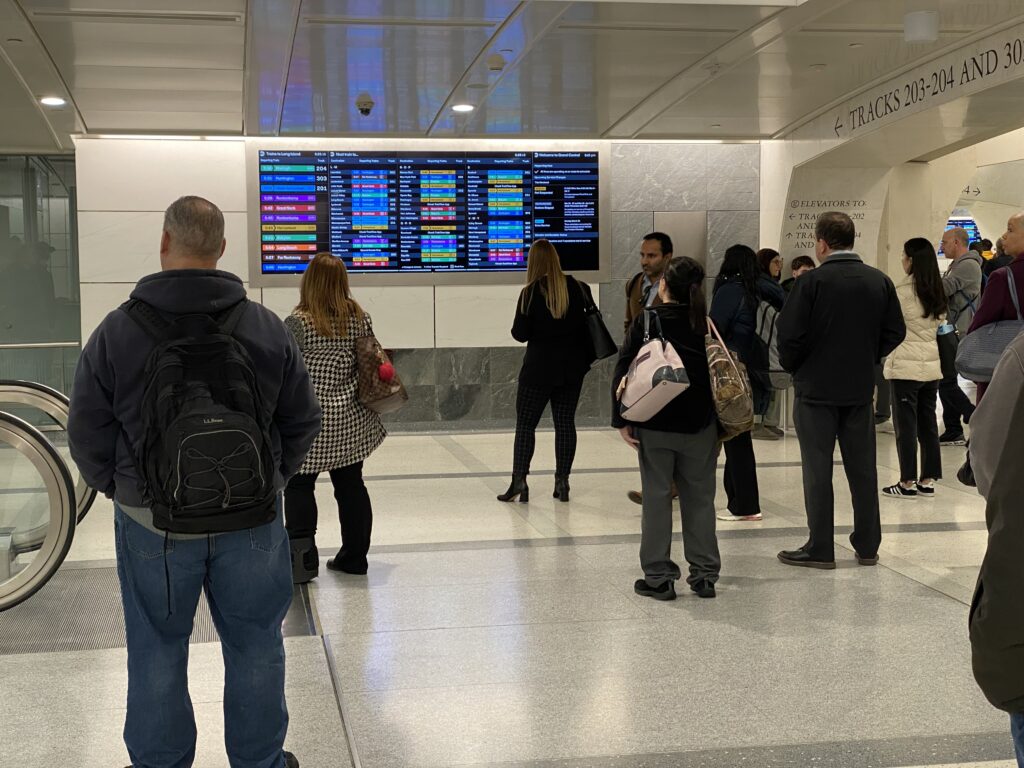
Interactive LIRR Map
Located in the center of the main concourse, is an impressive 30 foot wide, 11-panel array of 65” OutFront Videri screens. Eight of the screens display the full Long Island Rail Road system map. This dynamic display was designed by Applied Design and it depicts each branch line, track scheme, all 150 stations, town names, attractions and destinations.
The design was inspired by the original 1960’s status board located in the Jamaica Command Center. Working with partners at AV&C the team from Applied Design integrated real-time LIRR train data into the map to depict train movement along the ten branch lines and City Terminal Zone stations. In real time commuters can watch trains moving through the system. Once a train arrives at a station its name is illuminated and goes dark upon the train’s departure.
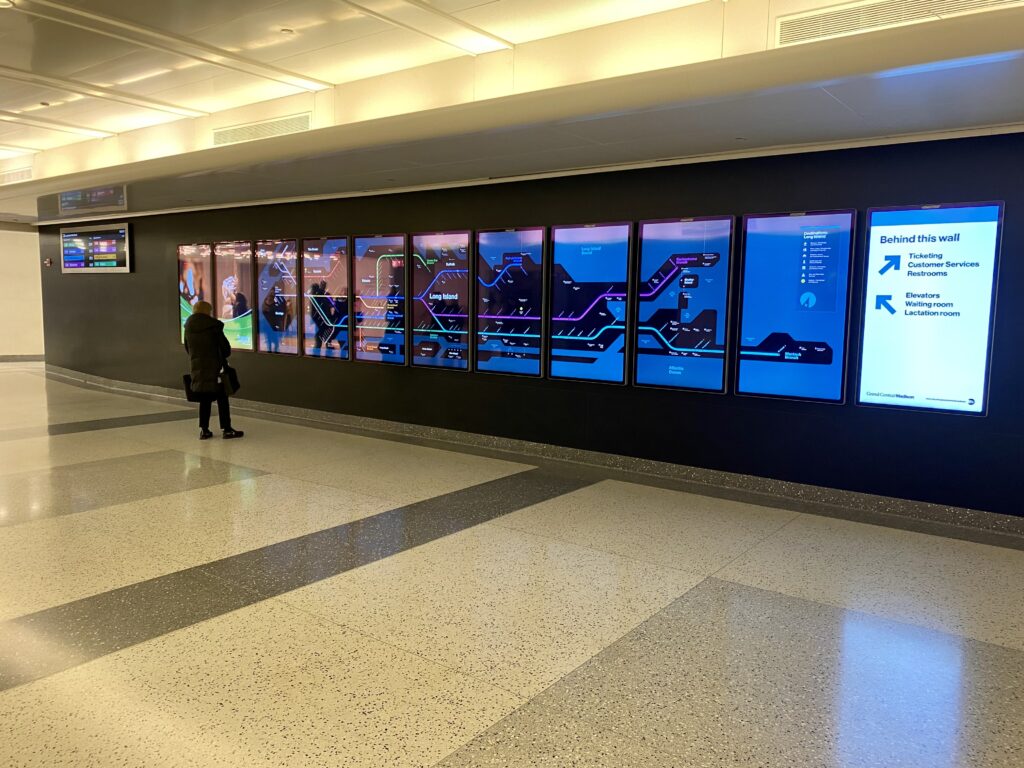
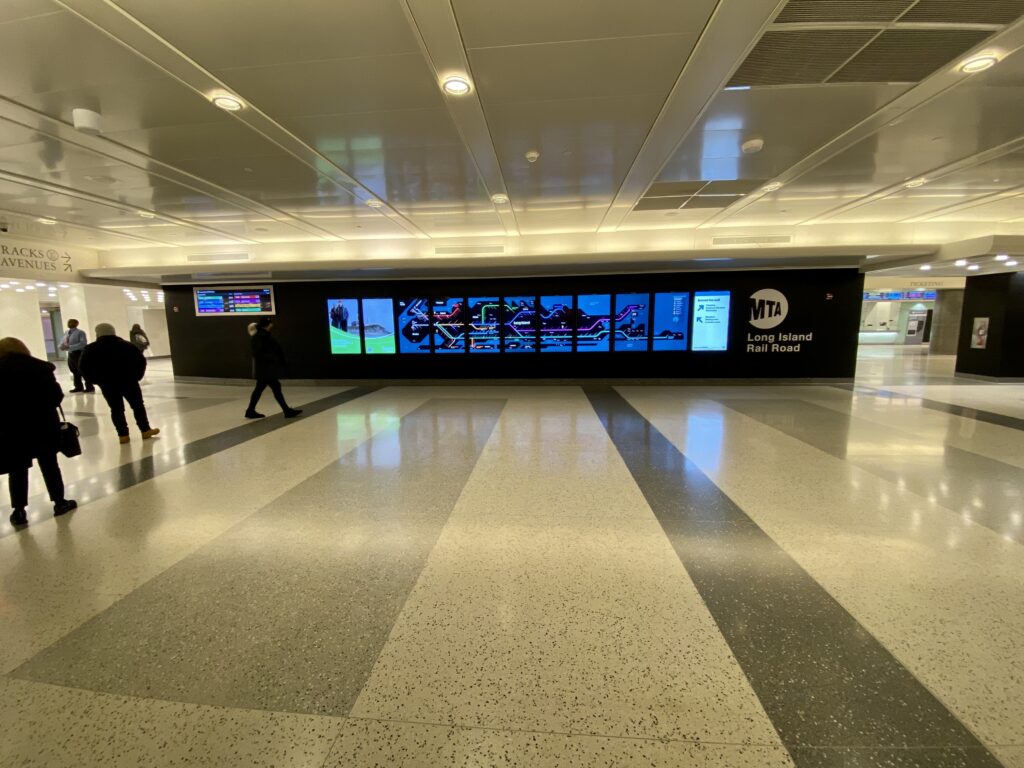
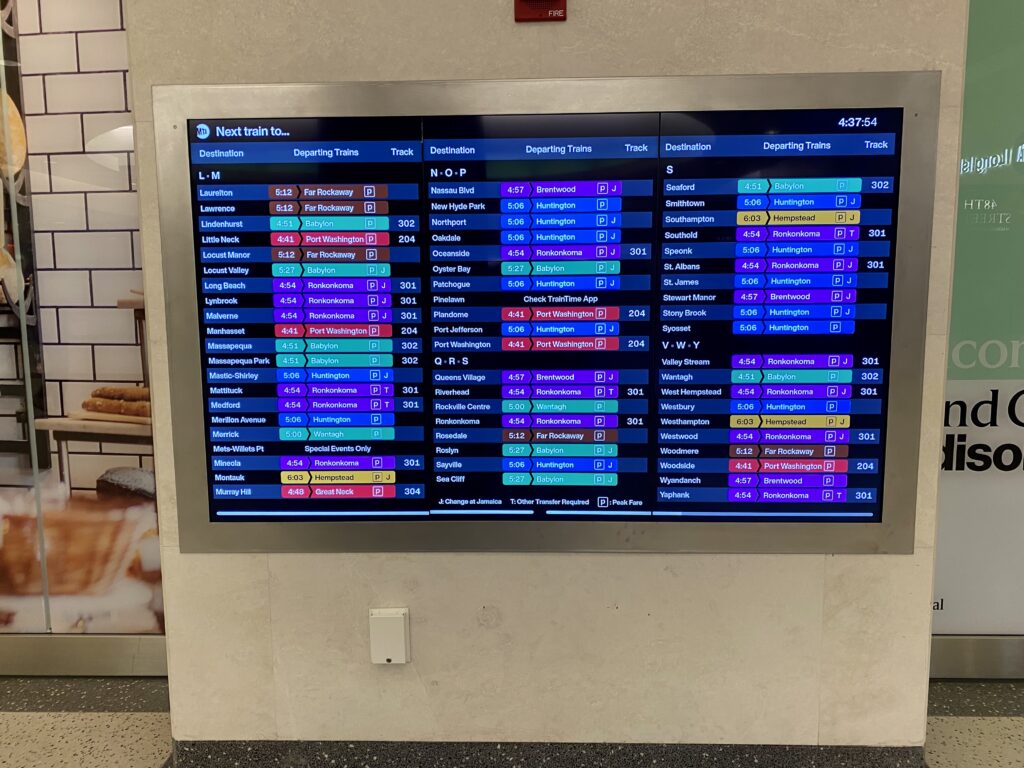
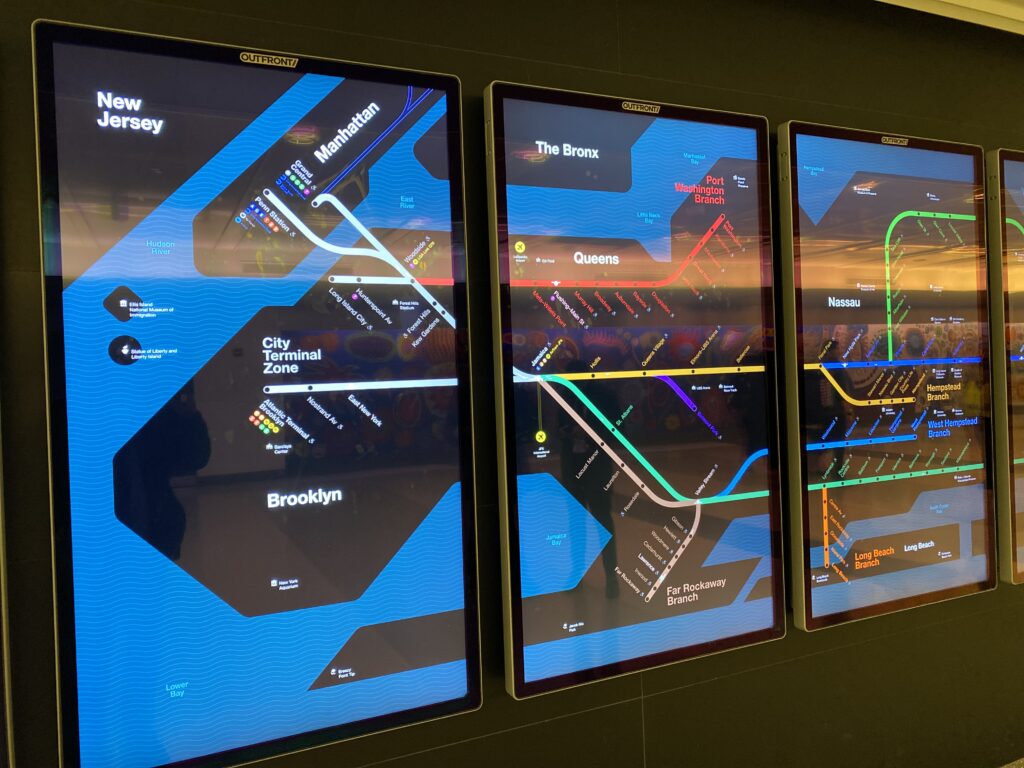
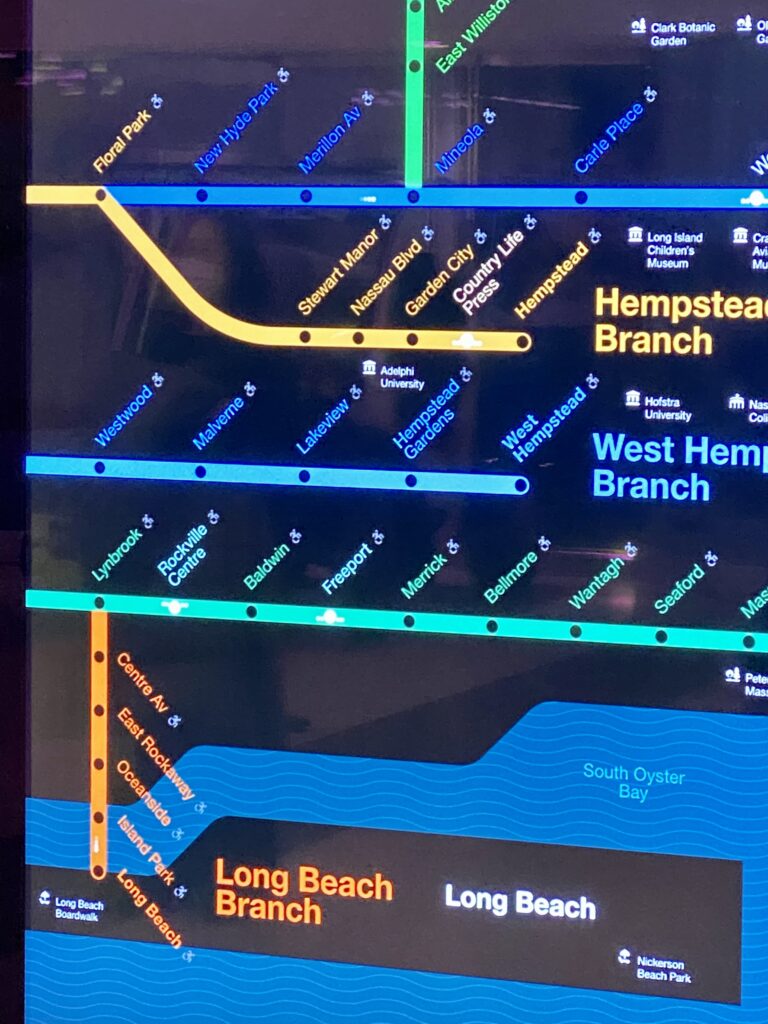
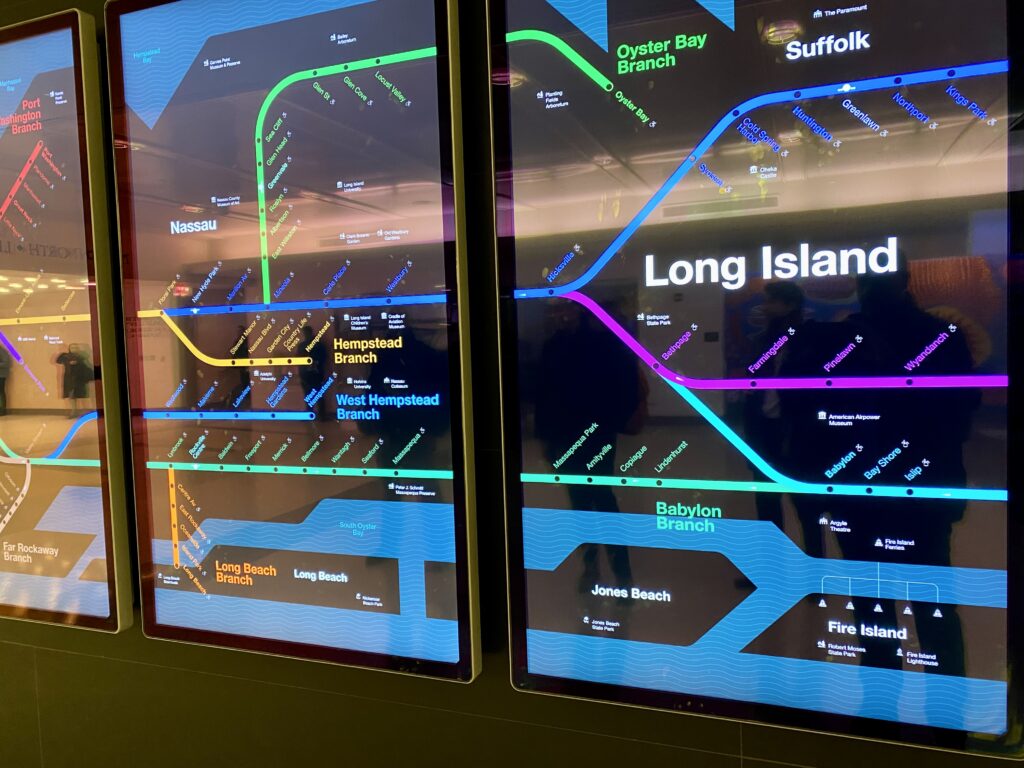
“The first objective was to create a map that integrated real-time data and technology into something representing the entirety of the LIRR system,” said Brad Scott, Founder and Managing Director of Applied Design. “Secondly, we wanted to make people aware of different attractions throughout Long Island. The map’s ultimate goal was to show the broad range of the LIRR system so that people could understand the expansiveness and richness of what was now available directly from Grand Central.”
The Ticketing Hall is located on the other side of the map. There customers can view general terminal wayfinding and more train departure information on Videri units positioned above each window as they buy tickets or speak to Customer Service Agents.
Digital Canvas
But the digital showstopper of the terminal is located at the north end of the concourse near the 48th St entrance. It’s here that the digital canvas — five separate massive dvLED panels installed by ANC — make for a truly eye-catching installation.
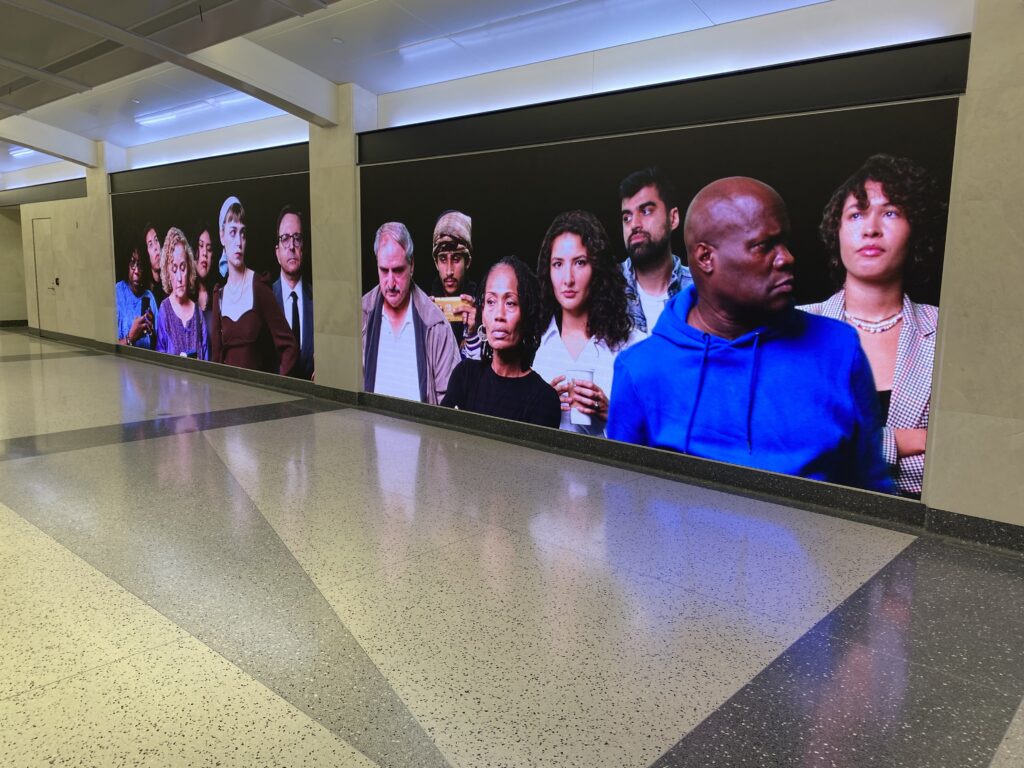
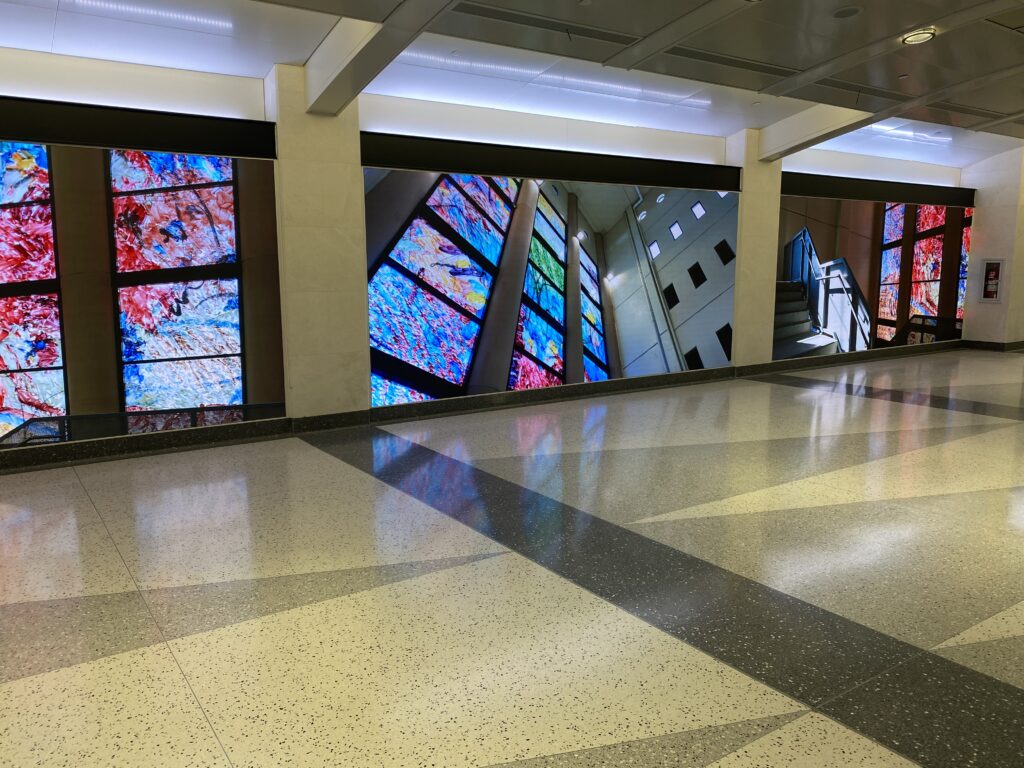
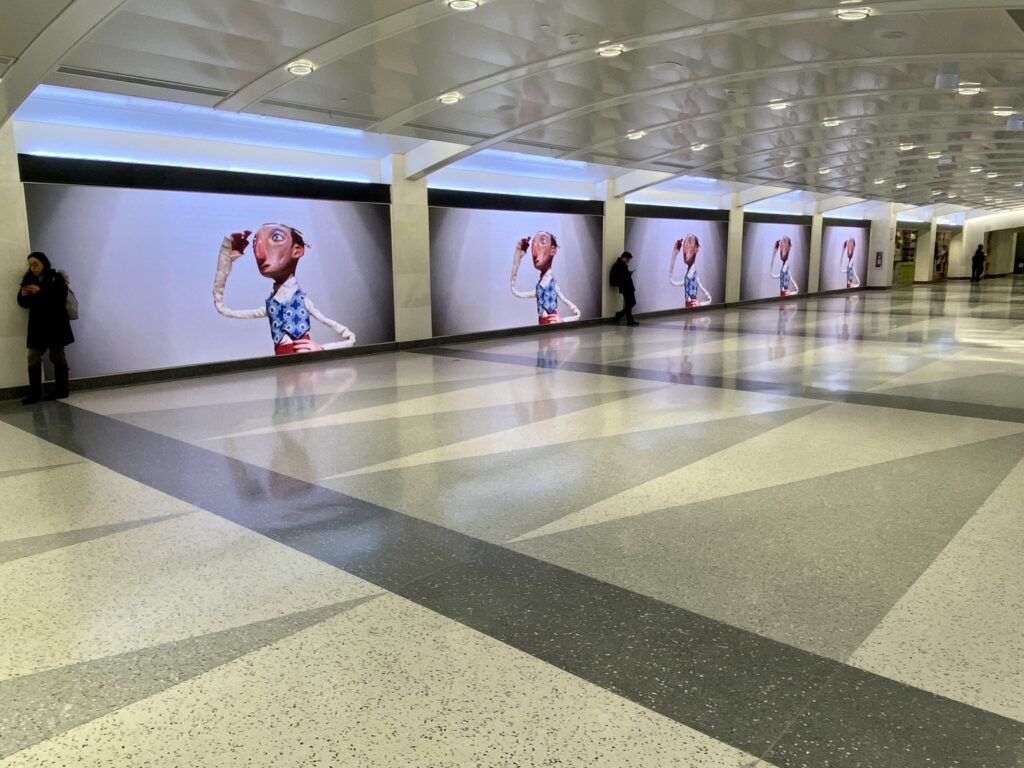
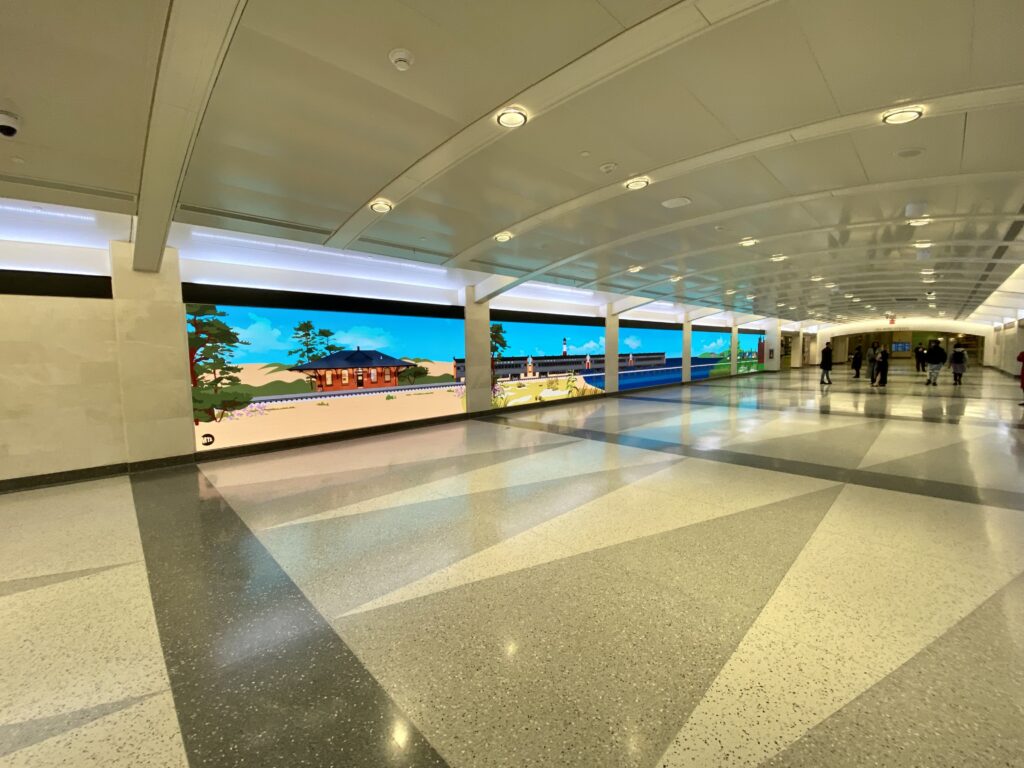
ANC worked with manufacturer partners digiLED and selected 2.604mm pitch for the (17.224ft) (w) X 2.25m (7.38ft) (h) displays. Each has a resolution of 2012(w) X 864(h). In total that’s 127 square feet of pixels which serves as the main digital canvas for MTA Arts & Design’s Digital Art Program.
“MTA Arts & Design is excited to expand our awarding-winning digital art program to the beautiful new Grand Central Madison terminal,” said Yaling Chen, Deputy Director, MTA Arts and Design. “Digital art viewed from a multitude of digital screens creates an immersive experience and engages the public with impactful visual moments. The five-channel monumental digital canvas at Grand Central Madison will become an everchanging portal for moments of imagination as people travel through the terminal every day.”
LiveSync, ANC’s proprietary Content Management System, drives the content and 24/7 scheduling for these new Grand Central Madison displays. “LiveSync allows ANC’s clients synchronized control over unlimited virtual pixels creating unique digital canvases across even the most complex public transit hubs like Grand Central Madison, Penn Station, Fulton Center, and the DC Metro system,” said Kirsten Savage, ANC Senior Director of ANC Studios and Venue Services. “It has been exciting to see artists lean into the capabilities of ANC’s LiveSync software to create award-winning art-in-transit digital media experiences enhancing the day-to-day journey for commuters and tourists in some of the most high-traffic destinations in the nation.”
Featured for the terminal’s opening is a series of digital art pieces including “Hat Trick,” by Red Nose Studios which depicts a cat and mouse chase through the terminal between a man and his bowler hat. Work from digital artist Gabriel Barcia Columbo is also in the rotation of the inaugural playlist. “Platform” is a two-minute slow motion piece that depicts the interaction between commuters as they notice one another other across a platform. The screens also feature MTA “Poetry in Motion” and other digital work, including pieces from the Grand Central Madison Student Art program.
Digital Mezzanine
Following a steep, 110-foot ride on one of four escalators that lead from the Madison Concourse riders arrive on the Mezzanine level of the terminal. On this lower concourse there are eight separate areas where passengers congregate before heading to one of the four upper or four lower track platforms. At each waiting area the MTA has positioned two Alpha Board video walls. Customers stand and train their eyes on the screens as they wait for track assignments to appear on the displays before making the mad dash to the platforms.
As weary commuters rush to the track level to catch their trains thirty-two Gate Curtain Displays show track specific information on two (2) 32” 1080 x 1920 LG TFT LCD displays. The screens show train departure and stop information to ensure riders catch the correct train.
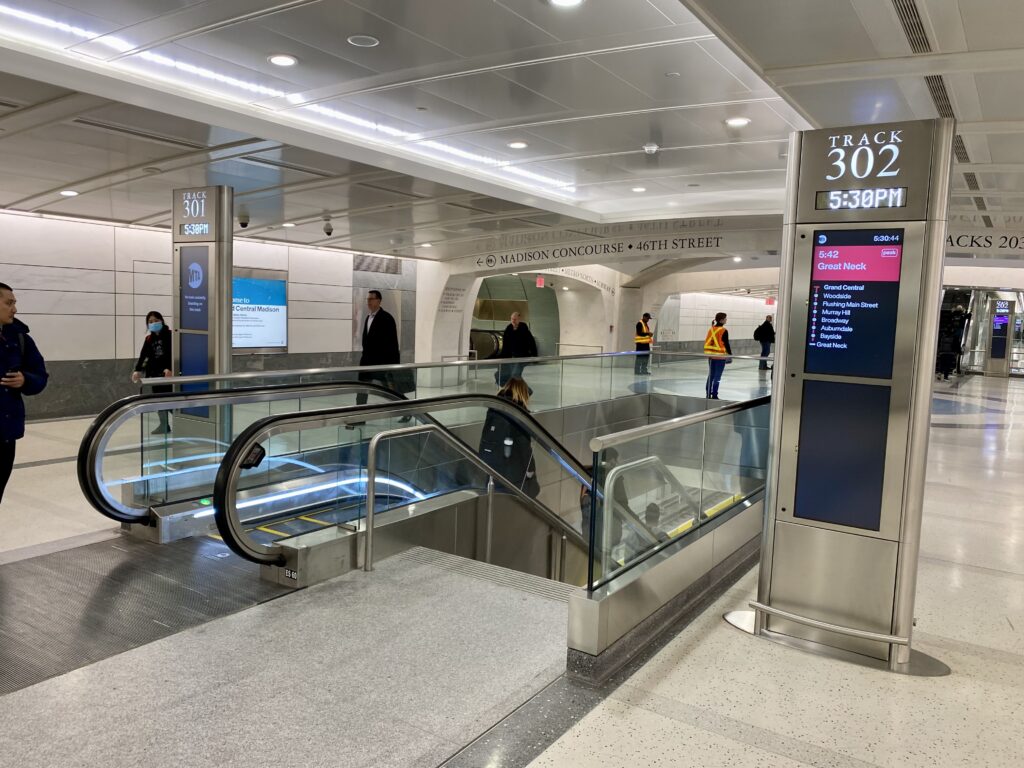
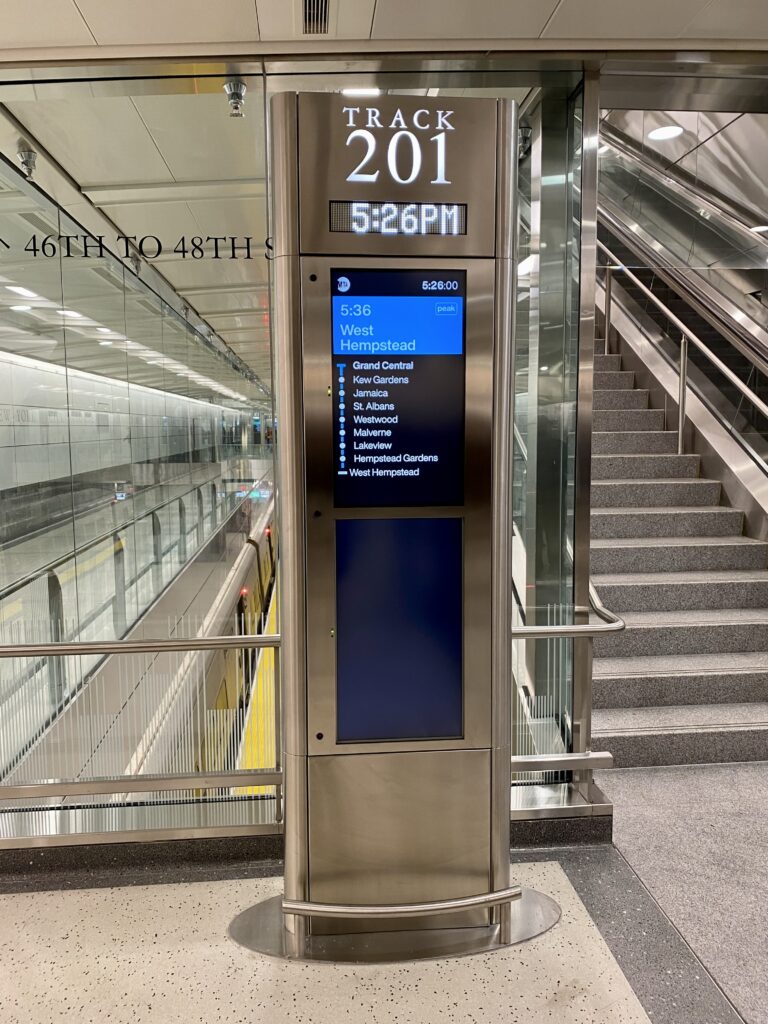
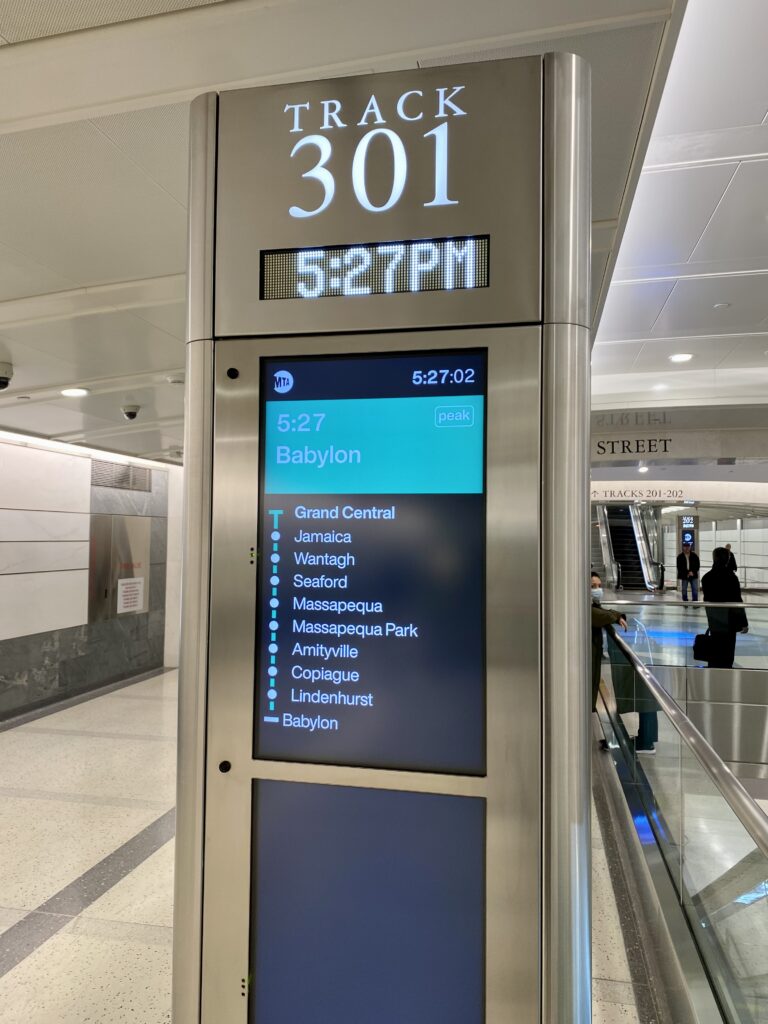
If for some reason a passenger misses all those screens, there are some sixty landscape 1920 x 1080, 21.5” LCD units along every platform as far as the eye can see. There are four screens per enclosure, with two screens mounted back-to-back. Each set of screens display the time, train, departure time and stop information. Screens are positioned about two car lengths apart along each track.
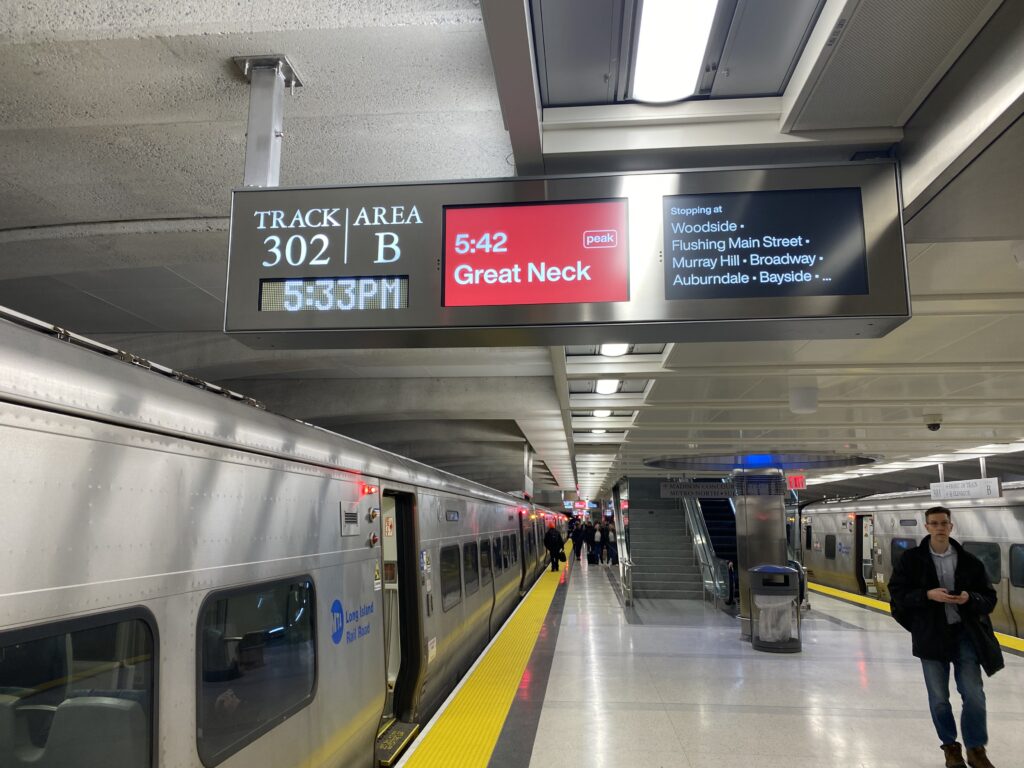
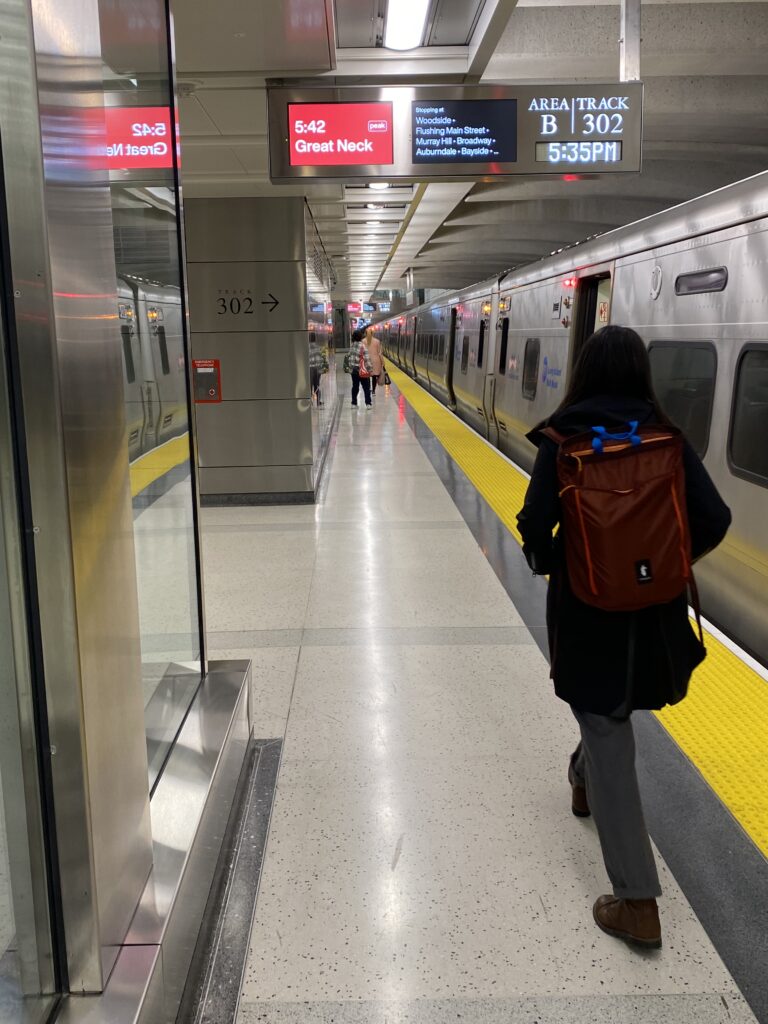
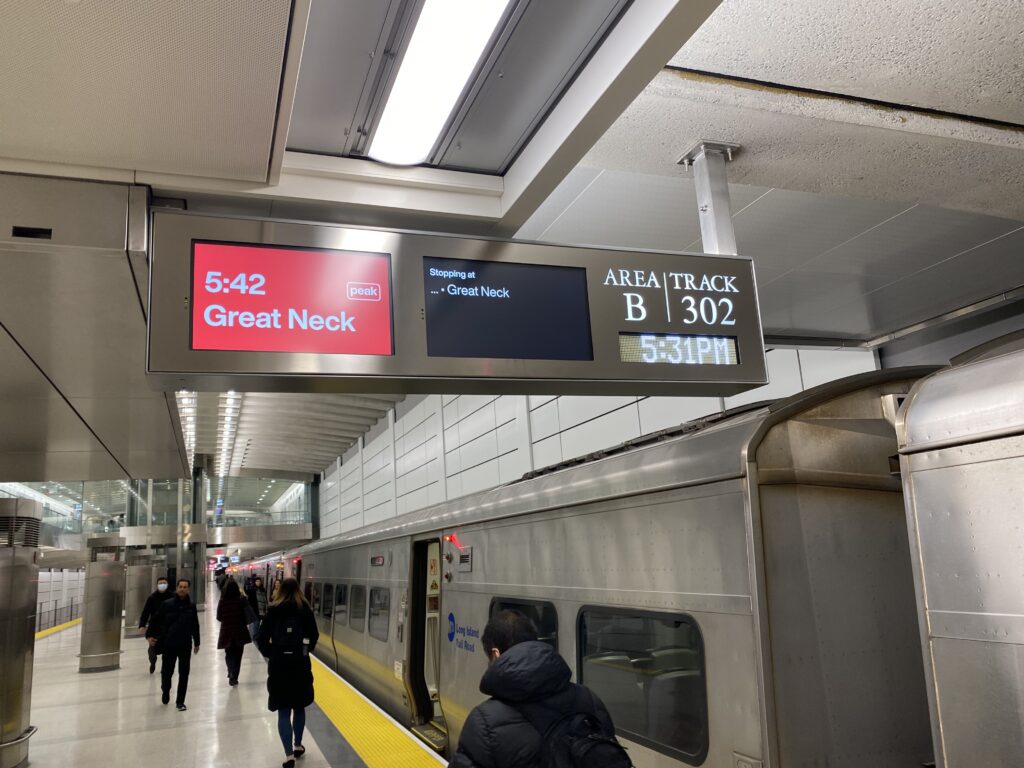
Yet despite all the train information displays there is a glaring absence of digital wayfinding information – where ticket machines and elevators are located, how to get to the track level – something that could have been solved with dedicated screens at customer decision making points throughout the facility. MTA officials say they are in the process of supplementing the existing wayfinding in response to customer feedback, adding it’s a work in progress given the wide-open nature of the space.
Digital First
All combined, the new terminal has well over two hundred individual screens – both LCD and dvLED – installed in an array of display configurations, providing customer information and engagement in addition to generating much needed revenue through DOOH advertising.
Grand Central Madison is the newest jewel in the MTA’s transportation empire, it’s also the most digital friendly providing Long Island Rail Road customers with a digital first experience as the LIRR embarks on providing a long promised one-seat ride to and from the East Side of Manhattan and points East. All Aboard!






